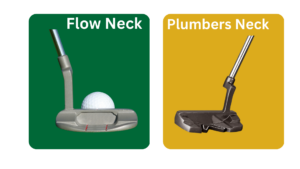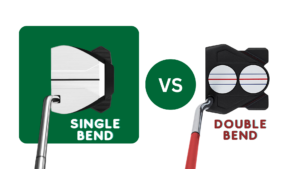If you’re an avid golfer, you know that choosing the right putter can make all the difference in your game. And when it comes to putter design, there are plenty of options to consider. Two popular choices are the flow neck and plumber’s neck putter. Both putters have unique features that can affect your putting stroke and ultimately impact your score. So, which one is right for you?
In this blog post, we’ll take a closer look at flow neck vs plumbers neck putter – exploring all aspects from design through to performance – helping you make an informed decision when choosing the right putter for your needs.

Table of Contents:
- Flow Neck vs Plumbers Neck Putter
- What is a Flow Neck Putter?
- What is a Plumbers Neck Putter?
- Design Considerations for Flow Neck and Plumbers Neck Putters
- The head shape and weight
- Shaft length and flexibility
- Performance Differences Between Flow Neck and Plumbers Neck Putters
- Accuracy and Distance Control:
- Feel and Feedback on Impact:
- Alignment Aids
- Cost Comparison of Flow Neck vs Plumbers Neck Putters
- Choosing the Right Putter for Your Game: Flow Neck vs Plumbers Neck
- FAQs in Relation to Flow Neck vs Plumbers Neck Putter
- Conclusion
Flow Neck vs Plumbers Neck Putter
When it comes to putters, golfers have a choice between flow neck and plumbers neck designs. Golfers must ponder the pros and cons of flow neck and plumbers neck putters when deciding which one to buy.
What is a Flow Neck Putter?

A flow neck putter is designed with the shaft attached directly to the head of the club in an uninterrupted curve or “flow” from one end to the other.
This type of design offers several benefits for golfers, including increased accuracy due to improved alignment on impact, enhanced feel and feedback from shots struck on center face contact, as well as increased distance control through more consistent ball flight patterns.
Additionally, many players find that this style of putter allows them to make smoother strokes with less effort required throughout their putting motion.
What is a Plumbers Neck Putter?

In contrast, plumbers neck putters feature a shaft connected at right angles (90 degrees) to the head which gives it its name – similar in appearance to how pipes are connected together in plumbing systems.
The primary benefit associated with this style of clubhead design is greater stability during off-center hits since there’s less flexing in comparison with flow necks when striking away from the sweet spot area on the face.
Furthermore, some players prefer this type because they believe it can help improve accuracy by providing better alignment cues at address than what you get with traditional blade-style models or mallet-type heads featuring high MOI properties.
When comparing these two styles side by side, there are pros and cons for each option depending on individual preferences as well as skill level playing ability.
For instance, if you’re looking for maximum forgiveness then a plumbers neck model may be the better choice due to its higher stability factor. On the other hand, those seeking improved feel and feedback would likely benefit more from going with a flow neck version.
Ultimately it comes down to personal preference combined with budget constraints when deciding which one best suits your needs overall.
In conclusion, both flow neck and plumbers neck putters have their advantages and disadvantages that golfers must consider when choosing the right type of putter for them. Ultimately, it’s essential to evaluate certain design elements when deciding which type of putter will be most beneficial for your game.
Design Considerations for Flow Neck and Plumbers Neck Putters
When it comes to design considerations for flow neck and plumbers neck putters, there are several key factors that golfers should consider.

The head shape and weight
The head shape and weight of the putter can have a big impact on performance. Putters with larger heads tend to be more forgiving, while those with smaller heads offer more control but require better aim. Heavier putters also provide more stability through the stroke, while lighter models can help increase swing speed.
Shaft length and flexibility
Shaft length and flexibility is another important factor when selecting a putter. Generally speaking, shorter shafts are easier to control, while longer ones provide greater reach in your setup position as well as increased power potential during the stroke.
As far as flex goes, stiffer shafts usually give you better feedback on contact whereas softer shafts may feel less jarring at impact but could cause mis-hits due to lack of feedback from the clubhead itself.
Overall, the design of a putter can greatly affect its performance and usability. Therefore, it is important to consider all aspects when choosing between a flow neck or plumbers neck putter. Subsequently, we will evaluate the differences in how these two varieties of putters perform on the golf course.
Performance Differences Between Flow Neck and Plumbers Neck Putters

Accuracy and Distance Control:
Flow neck putters are designed to help golfers hit the ball with more accuracy and control. The larger head size of a flow neck putter provides more stability, which leads to better distance control. Additionally, the deeper face profile helps reduce skidding on impact for straighter shots. Besides, if you want to play arc style stroke then you can rotate the putter face slightly with an arc style putting stroke.
Plumbers neck putters also offer excellent accuracy and distance control, thanks to their smaller head size and higher MOI (moment of inertia). This makes them ideal for players who prefer a softer feel at impact or need extra forgiveness on off-center hits.
Feel and Feedback on Impact:
Flow neck putters provide a soft but responsive feel at impact due to their larger heads and deeper faces. Players can get an accurate sense of where they’re making contact with the ball as well as how much force is being applied during each stroke.
Plumbers neck putters tend to have a firmer feel than flow necks due to their smaller heads and shallower faces. While this might not be ideal for some players, it can provide valuable feedback that helps you make adjustments in your putting stroke over time.
Alignment Aids
Both types of putter come equipped with alignment aids that help golfers line up correctly before every shot. Flow necks usually feature large alignment lines along the top edge of the clubhead while plumbers necks often include small sight dots near the heel or toe area instead. Both designs can be helpful when it comes to aiming accurately towards your target line, so you don’t miss any important short range puts.
Overall, the performance differences between flow neck and plumbers neck putters can be broken down into accuracy and distance control, feel and feedback on impact, as well as alignment aids for improved aiming accuracy. Moving on to cost comparison of these two types of putters, let’s take a look at price range for different brands and models along with availability of used or discounted models online or in stores.
Cost Comparison of Flow Neck vs Plumbers Neck Putters

When it comes to comparing the cost of flow neck vs plumbers neck putters, there are several factors to consider.
In terms of cost, you could find yourself shelling out anywhere from fifty to five hundred bucks depending on the features and quality. For the more sophisticated models, which typically come with advanced features and a greater range of customizations, you can expect to pay significantly more than for basic putters.
When looking at availability of used or discounted models online or in stores, you’ll find plenty of options if you know where to look. Online retailers such as eBay often offer great deals on used putters from top brands like TaylorMade and Callaway, so it pays off to do your research before making a purchase. Additionally, many golf shops have clearance sections where they sell slightly older models at reduced prices which can also help save money when shopping for a new putter.
Ultimately, choosing between flow neck vs plumbers neck putters really comes down to personal preference. Therefore, it is important to take advantage of any trial period offers available in order to get an idea of how each type performs during actual play conditions before settling on one over the other. By taking advantage of trial periods, one can guarantee they make the right choice for their game and secure a putter that will last.
The cost comparison of Flow Neck and Plumbers Neck putters can help golfers make an informed decision when selecting the right putter for their game. Next, we will discuss how to choose the best option by evaluating your putting style and testing out different models before making a final decision.
Choosing the Right Putter for Your Game: Flow Neck vs Plumbers Neck

When it comes to choosing the right putter for your game, there are two main types: flow neck and plumbers neck. Evaluating your putting style is key in determining which type of putter will work best for you. Flow necks have a more traditional look with a smooth arc from heel to toe while plumbers necks feature an offset hosel that creates an exaggerated toe hang.
Testing out different models before making your final decision is essential as each type has its own unique feel and performance characteristics. Flow necks tend to be more stable on off-center hits and provide better feedback on impact, while plumbers necks offer improved alignment aids for aiming accuracy. It’s important to try out both styles of putters in order to determine which one works best for you based on how it feels when striking the golf ball.
If possible, take advantage of trial periods or money-back guarantees offered by some manufacturers so that you can test them out without committing too much money upfront. This allows you to get a feel for how each type performs under real conditions instead of relying solely on reviews or opinions from others who may not have similar playing styles or preferences as yours. Armed with this knowledge, you can then pick the right putter type for your game and observe a decrease in scores over time.
FAQs in Relation to Flow Neck vs Plumbers Neck Putter
What is the advantage of a flow neck putter?
A flow neck putter is designed to help golfers achieve a more consistent stroke. It has an angled neck which helps create a smoother, pendulum-like motion during the putting stroke. This reduces the amount of wrist movement needed and can lead to better accuracy and control over long distance shots.
Additionally, it also allows for easier alignment as well as improved feel on contact with the golf ball due to its weight distribution. Overall, this putter is a great option for golfers seeking to refine their game.
Who should use plumber neck putter?
Plumber neck putters are designed for golfers who prefer a more upright putting stroke. They feature an extended hosel, which creates a higher angle of attack and provides the golfer with better control over their shot.
Plumber neck putters also provide greater stability at impact due to the increased weight around the head, helping to reduce backspin and promote forward roll on your shots. This type of club is ideal for players looking to improve accuracy and distance control when putting, as well as those seeking improved feel during their stroke.
What is the difference between flow neck and slant neck?
Flow neck and slant neck are two different types of putter heads. A flow neck is a type of putter head that has an even, straight shape from the shaft to the face. This design helps promote a more consistent stroke path for golfers who have difficulty controlling their putting stroke.
On the other hand, a slant neck is designed with an angled shape between the putter shaft and putter face which allows for greater accuracy in off-center strikes due to its higher moment of inertia and center shafted putter creates a good MOI and stability in the putter head.
Both designs offer distinct advantages depending on your individual style and preferences as well as playing conditions. Double bend and Single bend are good option for straight back and straight through.
Conclusion
When considering cost, however, the most important factor should be finding the one that best suits your golfing style. Flow necks provide increased stability on off-center hits while plumbers necks are more forgiving of mis-hits due to their lower center of gravity.
Ultimately, taking into account all factors such as design features, performance characteristics and price will help you make the best choice for yourself when selecting between a flow neck or plumber’s neck putter.
Discover the differences between a flow neck and plumbers neck putter to find which one is best for your golf game. Read our expert reviews on GolfingEagle.com to make an informed decision about your next purchase.






